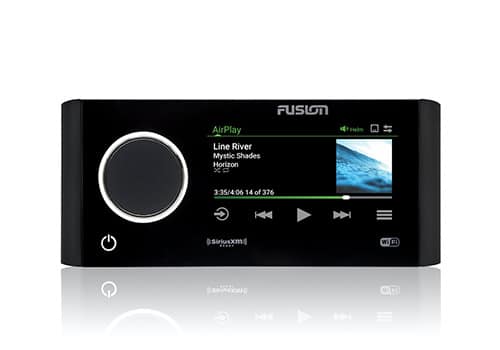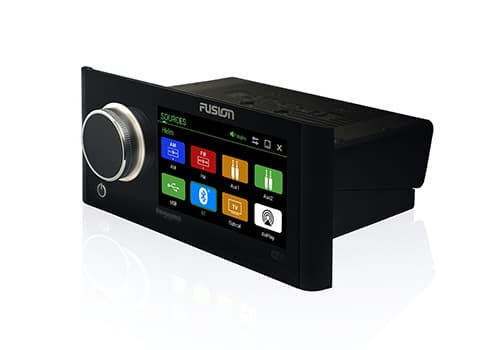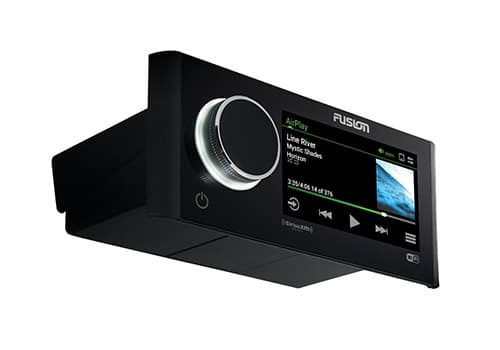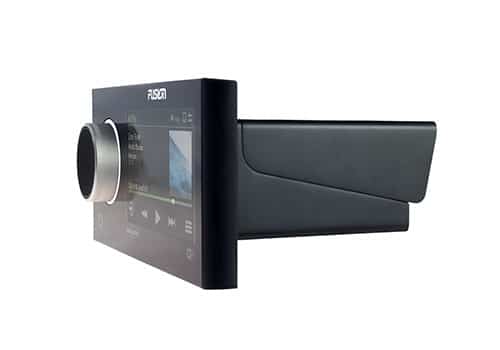Home > Product Installs & Reviews > Product Reviews > Car Stereos & Head Unit Reviews > Fusion Apollo MS-RA770 Marine Stereo Review
In this article: We'll give you a first-hand look and review of Fusion's Apollo MS-RA770 marine stereo. We'll walk you through some of it's key features and provide our own opinion along the way.
I remember in the 2000s when Mp3 players were just making a serious appearance with the original iPod. And I also remember cruising down the river listening to some music via our CD player (which was modern at the time) only to hit some chop from a passing boat. We would all but lose our music for 5-10 seconds at a time as the CD skipped and tried to find it's position again. I remember thinking to myself – is this really where technology is right now?
Marine head units today aren't as simple as they once were, but in a good way. CDs are a thing of the past, replaced by more modern, digital and streaming forms of music. And having a few coaxial speakers in the interior of your wakeboard boat with a CD player doesn't cut it today – tower speakers, subwoofers and interior speakers have made it necessary for zone control. Stereos are requiring more power, more amplifiers, etc. In general, the older marine head units really aren't designed to keep up with the evolving and more complex marine stereo. Even today, you still see a lot of work arounds that boat owners are doing to try to get the ideal combination of control, performance, and convenience out of their boat's stereo. I.E. the Wet Sounds WS-420BT (which I personally still love) – volume, sub, zone and equalizer all in one with Bluetooth connectivity.
Luckily, manufacturers like Fusion, Wet Sounds, Kicker and others are really starting to address some of the painpoints that come along with the evolving boat stereos with their latest marine head units.
We were lucky to receive one of Fusion's latest marine stereos for testing – the Apollo MS-RA770 – and in this review, we'll walk you through some of its latest and key features and give you our honest opinion of the unit. And be sure to check out our list of Best Marine & Boat Stereos, where this head unit made the list!
About Fusion
For those of you who may not know, Fusion is actually now a Garmin brand. In 2014, Garmin announced the acquisition of Fusion Electronics to add to it's growing line of marine and automotive products. Fusion was founded in New Zealand in 1998 by Sir Peter Maire as a home grown car audio brand and grew to be a global audio brand. As Fusion grew, they entered into the marine world extending their established audio tech into the world of boats. With over two decades of engineering and designing automotive and marine electronics, Fusion's focus is quality and acoustic excellence.
Unboxing the MS-RA770
Fusion's Apollo MS-RA770 comes with all of the typical necessities that a high-end marine stereo would come with. It's neatly packaged and sealed from the elements, and also protected from its own hardware within in the case of rough shipping. All of the wiring is neatly tucked into a bag at the front side of the box along with a few thick manuals and a mounting template.
The hardware and wiring itself isn't like your typical automotive hardware and wire harnesses. All of the harnesses that plug into the back of the head unit are water resistant with a rubber-like seal around the outside of the male side of the plug. The mounting screws are stainless and it even comes with mounting gaskets that fit around the outer edge of the head unit to seal it to the mounting surface. Finally, while digging around in the box you'll find a rubber front-cover to protect it from the elements when you're not using it.
Recent Reviews & Articles
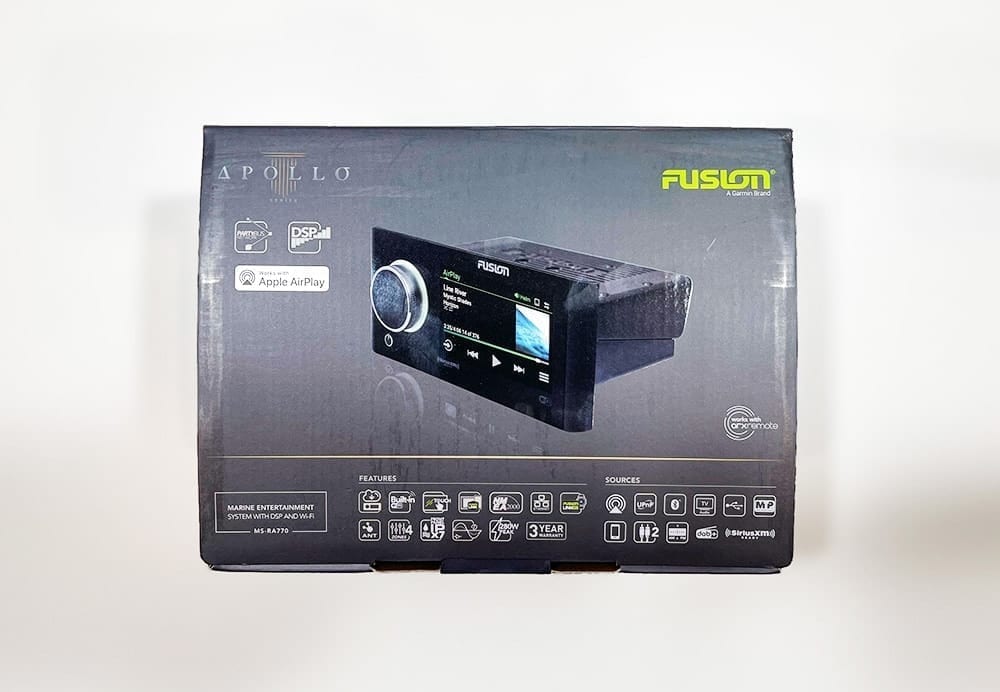

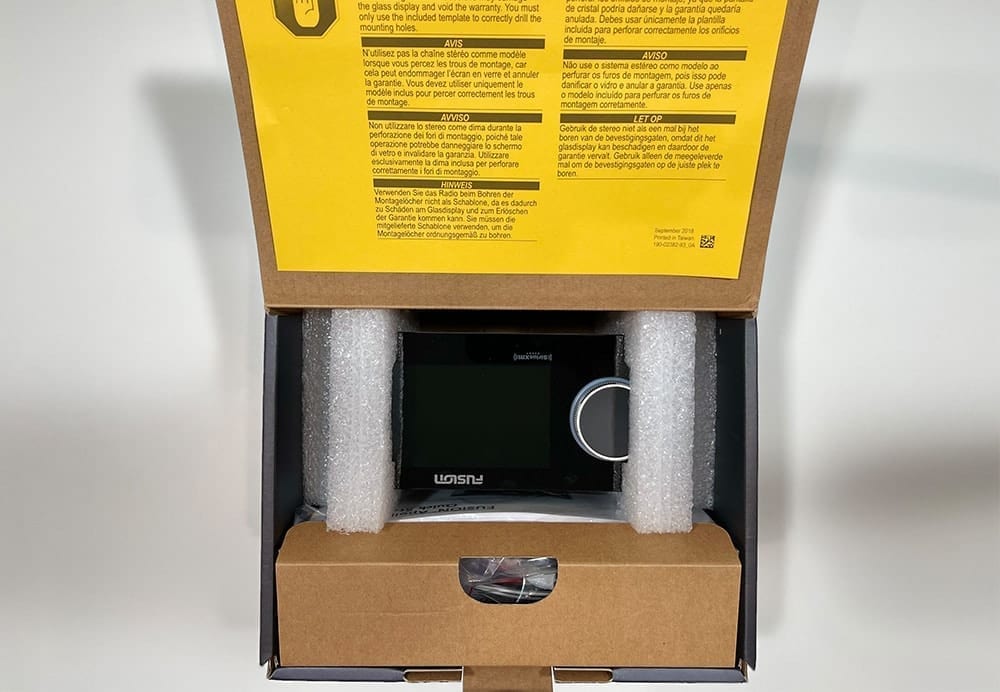
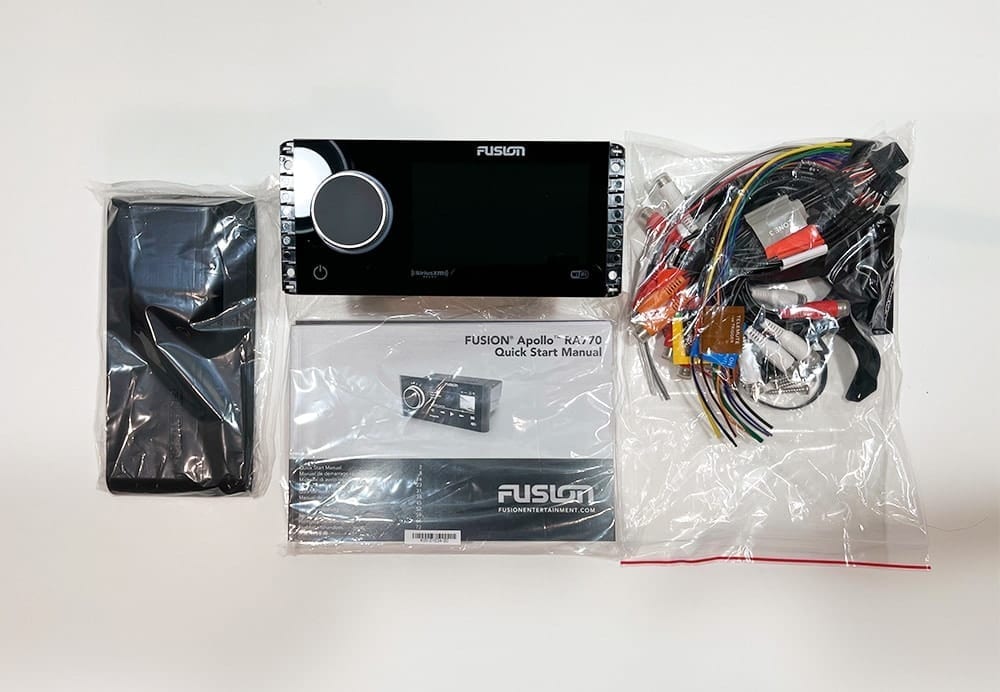
First Look and Impressions
When we opened up the MS-RA770 for the first time, the first thing we took a look at was the screen and the chassis. The screen is a 4.3″ capacitive touch glass display. It's really sleek and modern looking and has the feel of your iPhone or Android's touchscreen. With the exception of the volume/selector knob it's pretty much just one sheet of glass which is a good thing considering it's meant to be resistant to moisture, corrosion, dust etc. And I actually really like the oversized, simple knob. Fumbling for the volume or trying to make adjustments when you're underway on the water is tough as it is so I really like the simplicity in the case that you don't want to use the touchscreen.
The chassis isn't a 1 DIN, 2 DIN or 1.5 DIN which means it's pretty much going to need an adapter if you have any of the standard DIN size equipment on your boat. It's also a different dimension as some of the other marine head unit/source manufacturers like Kicker and Wet Sounds, so make sure you measure where you're installing this unit and be prepared to make adjustments to the mounting hole that you have.
Looking more at the chassis it's definitely a marine grade unit – everything is sealed up well. Even the harnesses that connect into the back of the unit are water resistant. Although, things like the ethernet input, usb, SiriusXM tuner input are all standard which might make these components vulnerable (see the rear shot below).
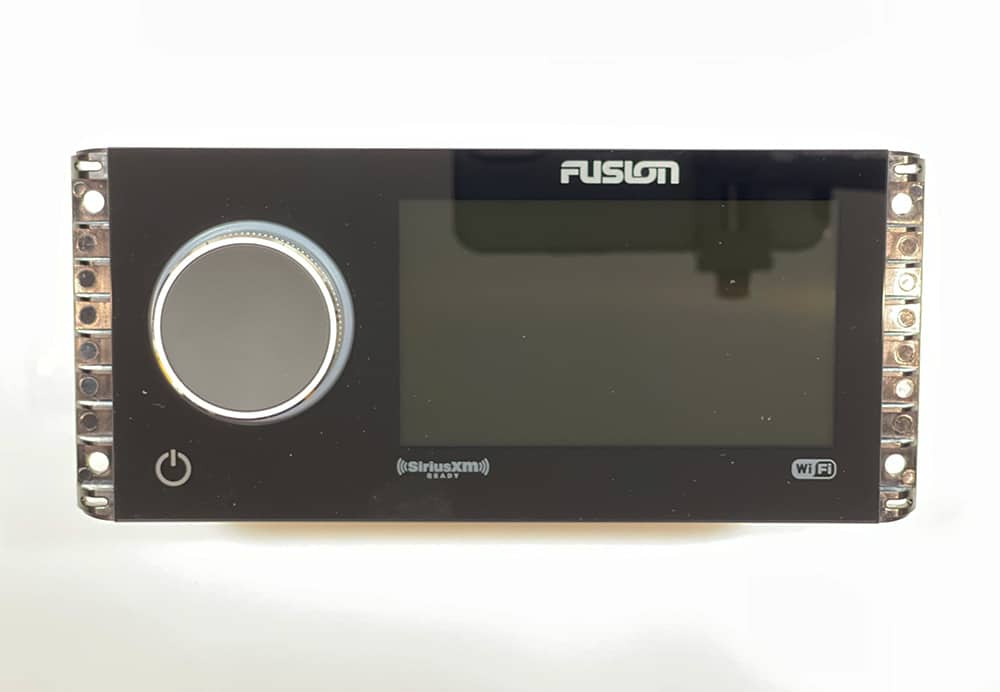
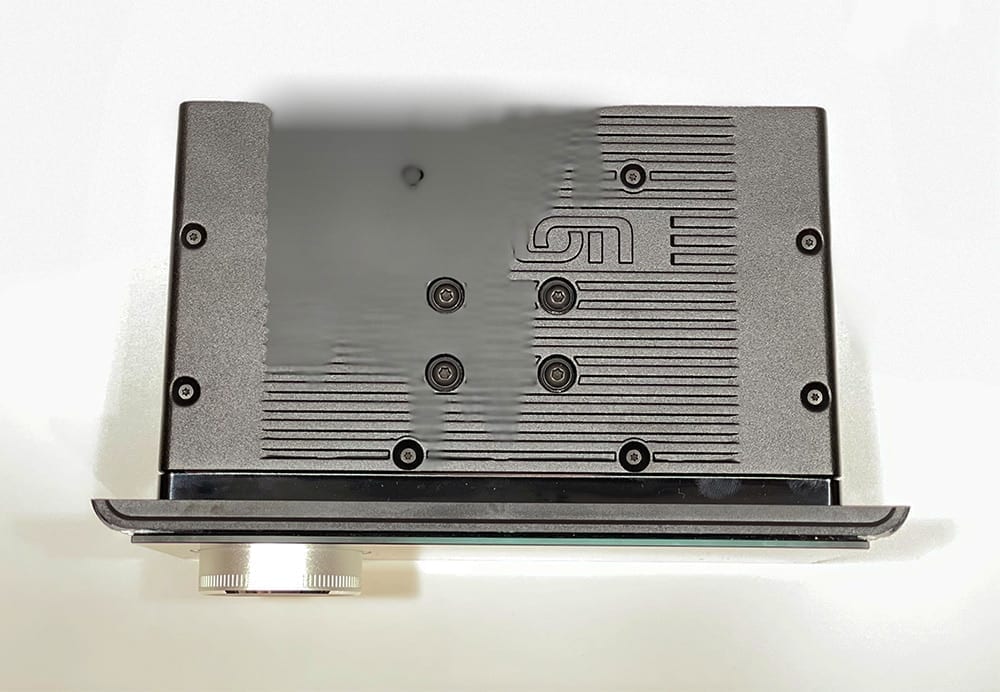
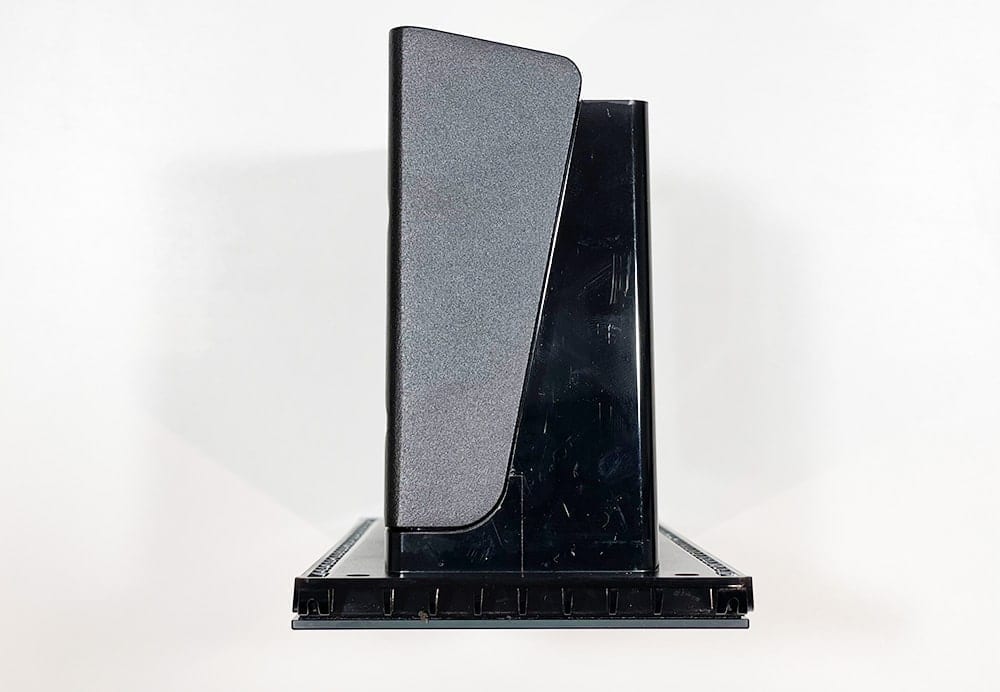
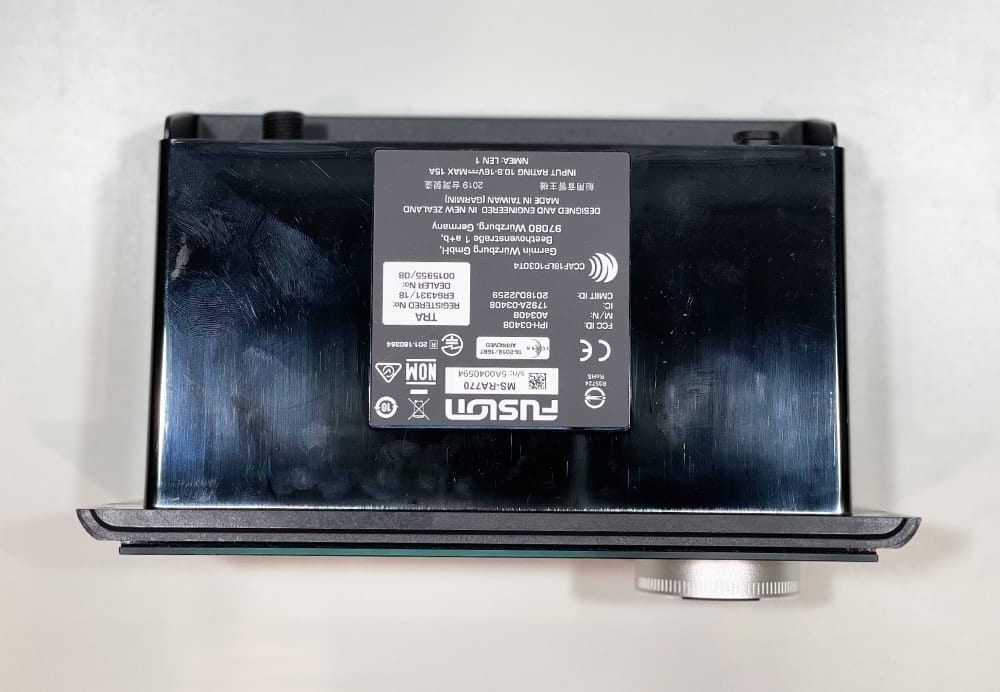
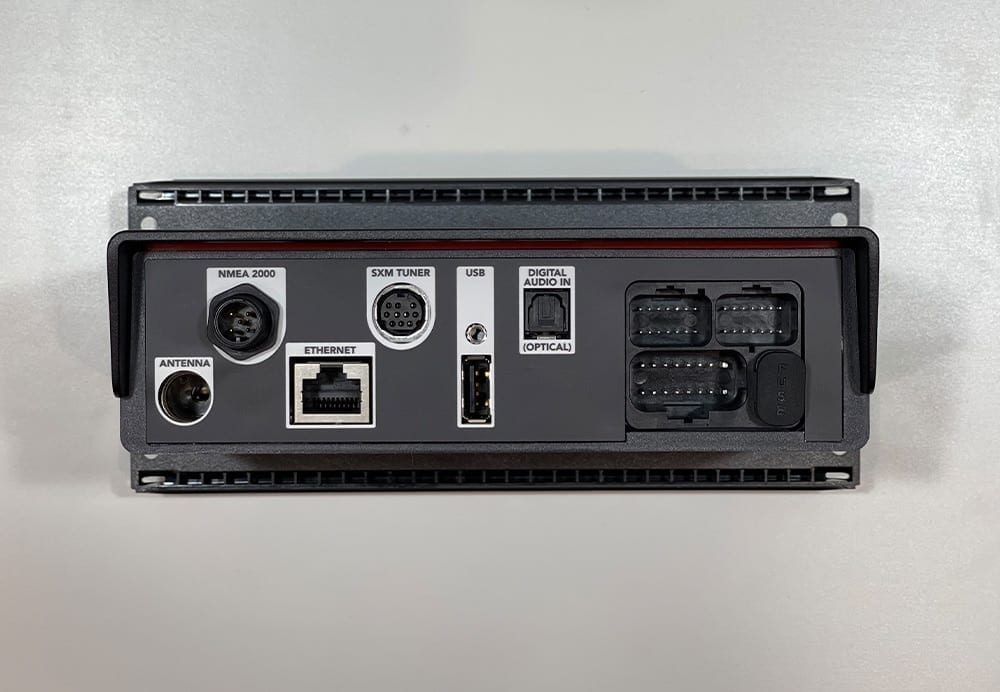
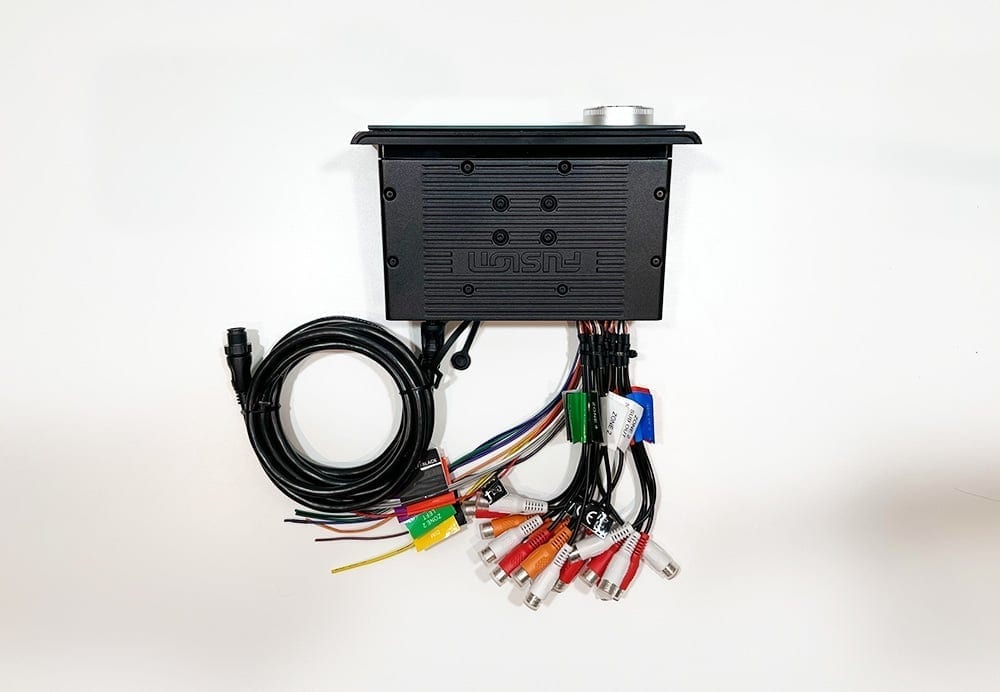
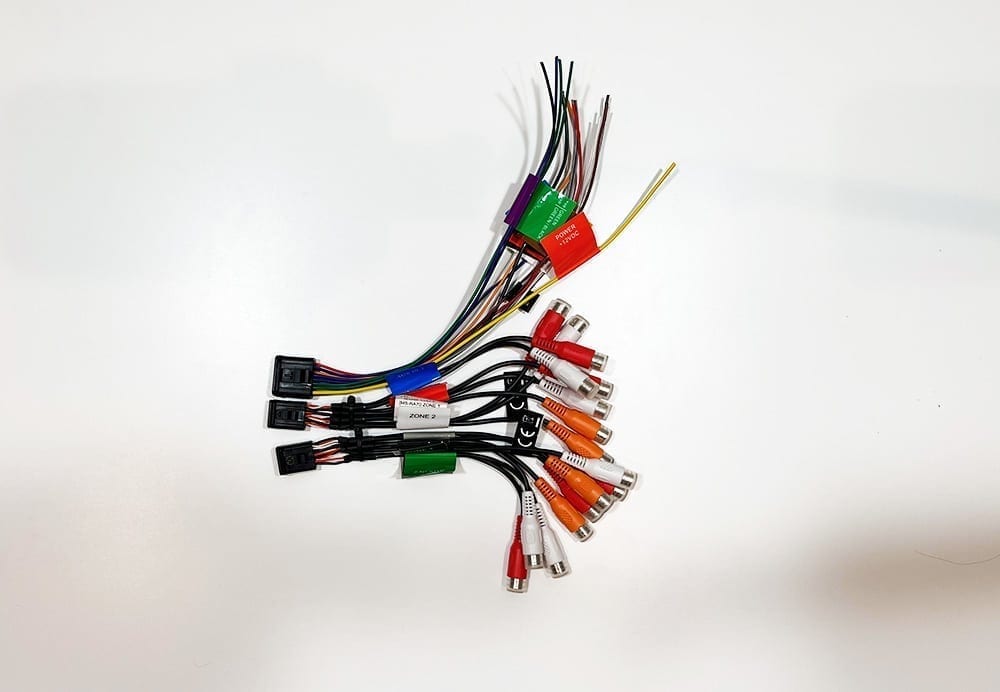
Running Through the Key Features
Usability and interface, connectivity and expandability, audio quality and control – these are just a few of the things I think of first when I'm looking at a marine head unit. They're what makes the difference when you're on the water in a cove, cruising on glass or towing a rider behind the boat. Let's walk through some of the MS-RA770's features and if/how they're useful while you're on your boat.
Touchscreen and User Interface
Just because it's really the first thing you see and how you interact with the entire unit, I'll start with the touchscreen and the user interface. According to Fusion, their MS-RA770 is “the world’s first purpose-built marine entertainment system with a one-pieceglass touchscreen display”. The touchscreen is a 4.3″ LCD capacitive touchscreen. The actual glass that covers the screen seamlessly spans the entire unit though which is what they're referring to when they say it's a “one-pieceglass touchscreen”. Capacitive touchscreens are what your iPhone and Android devices use so you can expect a similar feel and response.
When browsing through the controls, settings and features of the unit I felt that the touchscreen was a really neat feature and gave a lot of added control. It's super responsive and makes selecting items and song control pretty easy. Although I think that, like most smaller touchscreens, some of the controls are small and my fat fingers don't make selecting the ‘close' or ‘back' buttons that are at the very top-right hand corner easy. The scroll feature in the settings and menus in the unit via the touchscreen was a little tough for me as well and I found that the knob was more effective for highlighting and selecting in some cases.
In some cases, I found it easier to use the oversized volume and control knob to assist with controlling the unit. It allows you to control volume, but as soon as you enter into the settings or control areas in the interface it becomes a scroll/select knob. All-in-all, I think a combination of using the touchscreen and the knob make for a really efficient way to navigate through the MS-RA770's features and controls and make it one of the most user-friendly marine stereos on the market.
In terms of the screen image quality, everything looked great to me. It's really not displaying any high definition video or imagery though so there's not too much to note. But the music album imagery, text, colors and everything looked vibrant and clear.
User Interface
The user interface is pretty straight forward and easy to navigate. You have three main launch-points on the touchscreen:
- Source (bottom left)
- Menu (bottom right)
- Zone Control (top right)
It's a two-tap process to switch sources which is really nice – tap the source button, then tap the source you want to use. The menu is pretty standard – it shows artists, playlists, albums, etc from the device that you're connected to. It's worth noting that the menu only shows the downloaded songs, albums and playlists on my iPhone, not the songs in my Spotify or Pandora app. So if you use a streaming app like these, you won't have that level of music control.
To get into the deeper settings, you click on the gear icon at the top After you enter the menu. Within you'll find things like WiFi settings, AirPlay, brightness and zone settings. The zone control is super customizable and relatively easy to configure and use as well (we'll get into this more further in the article).
All of the head unit's standard controls are pretty easy to navigate through. Some features like the zone control, AirPlay, WiFi and the PartyBus Network feature are more challenging to setup and configure at first, but a quick glance at the manual should help you through most of those configurations. I did find the ‘Quick Start Manual' lacked instructions for a lot of deep functionality though and left a lot to guesswork. And there wasn't another manual that gave a walkthrough of some of the deeper configurations like DSP. I was able to work through most of the general setup – WiFi name, passwords, AirPlay, Bluetooth, zones, etc in about 15 minutes though and now that I've browsed through the whole interface it all makes sense. But I would recommend setting aside a good 15 minutes to walk through the features and configurations of the unit, otherwise I don't think you'll really be able to use this unit to its full potential.
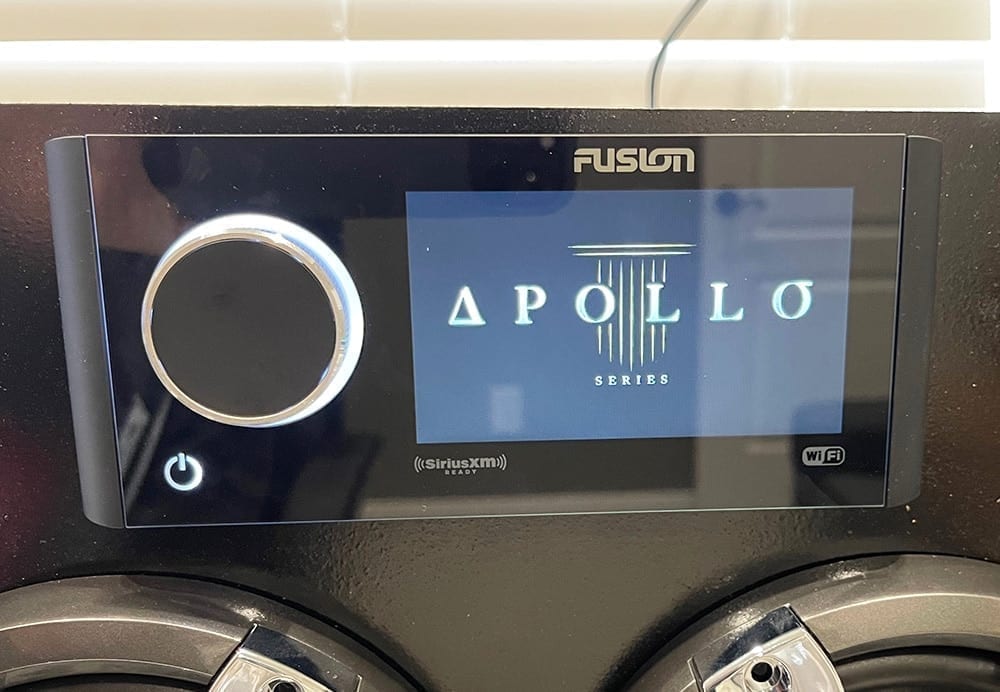
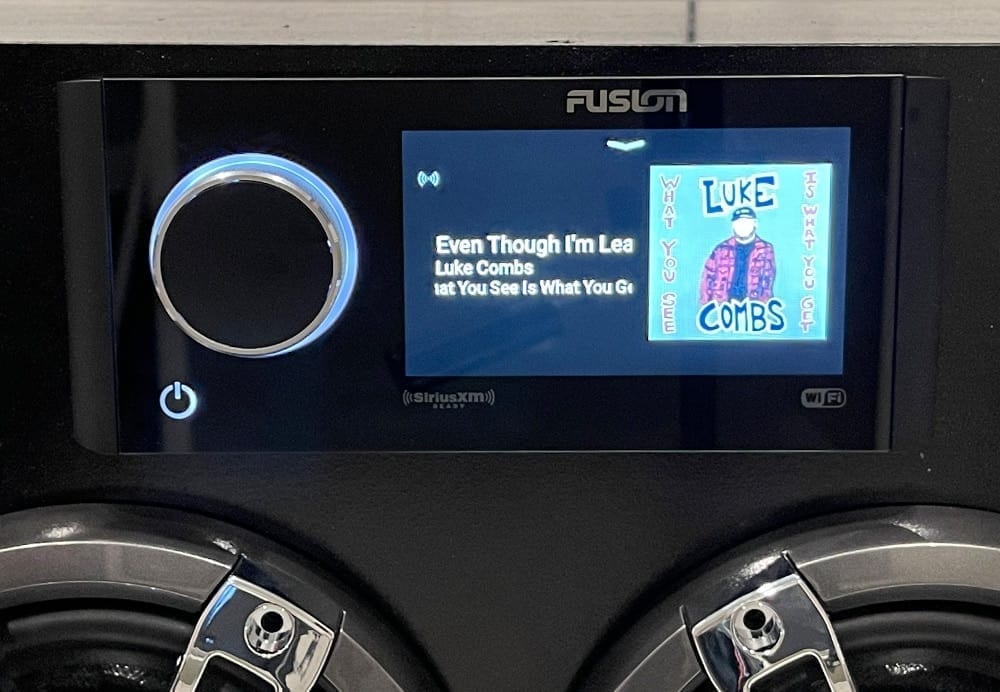
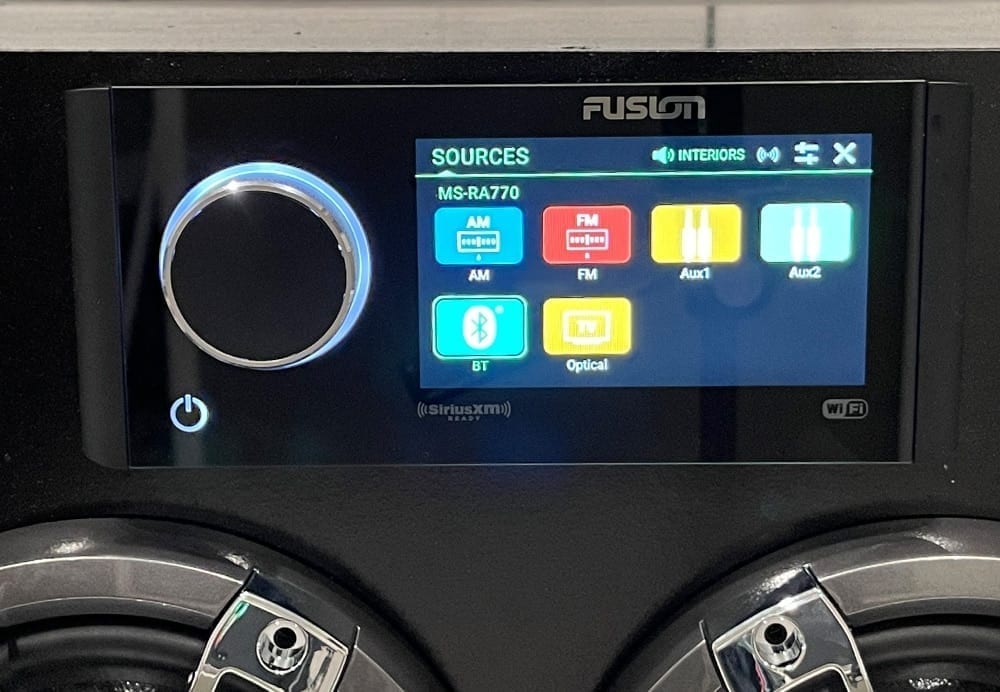
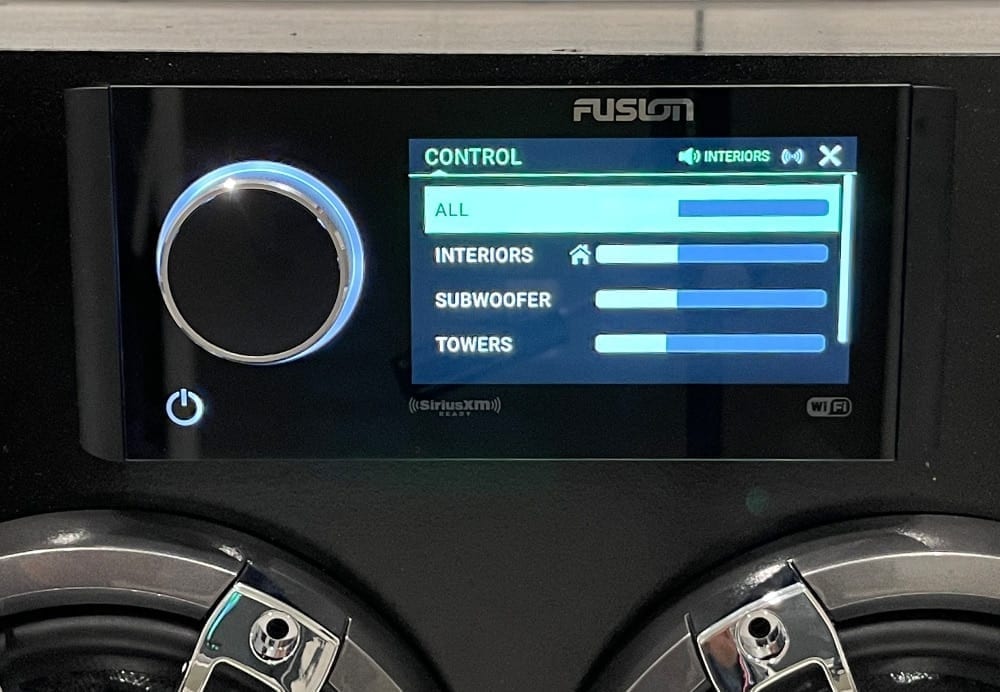
Connectivity: AirPlay, Bluetooth, USB and More
The ability to connect to your device of choice for music is more essential today than ever before. Whether that's a phone, a USB drive or XM radio – CDs are obviously a thing of the past. The more ways you can connect to your music device, the better. Fusion's MS-RA770 really gives you a wide variety of ways to stream music from any device. The only one that's missing is a direct aux-in via a headphone jack, but there are two universal RCA aux inputs on the back that can be used with a RCA to headphone jack adapter like this one and placed anywhere on your boat to connect to.
Let's walk through the connectivity options on the unit.

Apple AirPlay 2
So this is one feature where I feel like Fusion differentiates itself from its competitors. The MS-RA770 has AirPlay built into it, so if you're on an Apple device you'll probably use this feature a lot if you are experiencing choppy music as a result of the limited range of Bluetooth.
And if you're wondering what the difference is between Bluetooth and AirPlay, it's in the technology that's used to wirelessly connect to your device. Bluetooth and AirPlay are similar by nature – they both use radio waves to communicate between electronic devices. But AirPlay uses WiFi technology, which is the same as what's used in your home internet. You may have already experienced the limitations of Bluetooth's range on your boat just by keeping your phone in your pocket and walking up to the bow or the stern of the boat. WiFi/AirPlay is a much more efficient and has a much further range than WiFi.
I put the two to the test, taking my iPhone in my pocket at distances in my home from the head unit while playing music. Bluetooth started to get choppy at about 20-30ft when I was testing. But for WiFi, I couldn't get it to lose signal in my home which exceeded about 50 feet, two stories and several walls in between. The shortfall to WiFi, in my opinion is interference. WiFi/ApplePlay uses the same range of frequencies as so many other devices that it's prone to interference. I noticed this while testing the unit in my home. I played music for about 10 minutes via Bluetooth and then 10 minutes using AirPlay. Bluetooth was uninterrupted during the test period but when I was using AirPlay, I did get some interference where the music would cut out one or two times. My phone was less than 5 feet away from the head unit both tests. But, it's worth noting that I have 30+ devices that share the same network in my home and live in a townhome with a neighbor that also probably has an equal number of devices on WiFi. I'm in an area that's prone to interference. When you're on the water, you're not likely going to be in an area that's prone to WiFi interference. At the time of this review I wasn't able to do a test on the water though.
Connecting to AirPlay definitely isn't as straight forward as Bluetooth, but after you configure it for the first time you shouldn't have a problem. You can connect to AirPlay in one of two ways in the Network settings of the unit:
- As a client:
- You can connect the head unit to a WiFi network (like your home), then connect your streaming device to the same network that your head unit is on. Once that's done, select the Fusion device on AirPlay when you play your music. ‘As a client' probably more suitable for those who use the head unit as a music source in their backyard, dock, or yacht where static WiFi is available.
- As an access point:
- For those who will be on the water, away from an available WiFi source like your home, this is likely the option you'll use. The MS-RA770 will create the WiFi access point/hot spot. You'll connect to the head unit directly in your WiFi setting in your streaming device first. Then select the Fusion device on Airplay when you're playing music.
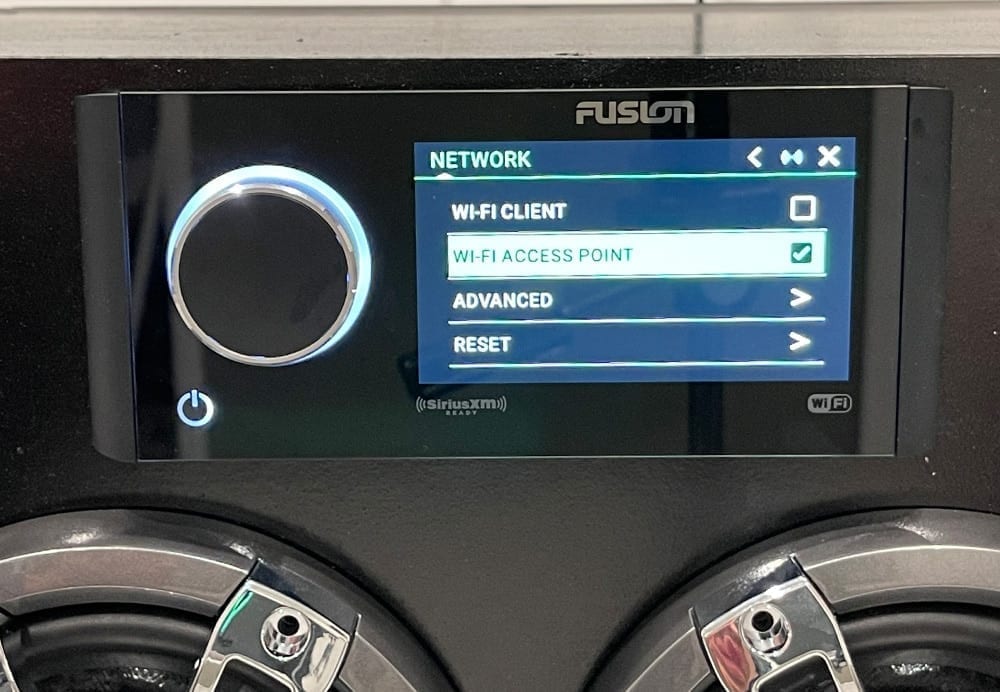
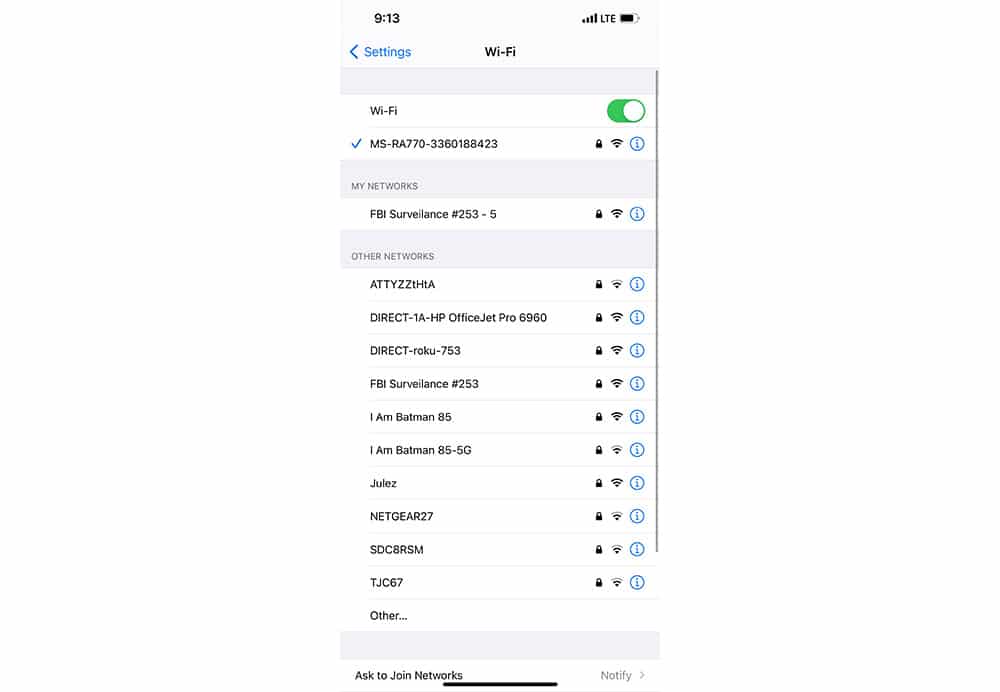
Bluetooth and USB
Bluetooth and USB is standard in 99% of all head units now – automotive and marine. And the Fusion MS-RA770 comes equipped with both of those. You can hook into the unit with almost any device via one of these two methods.
Bluetooth configuration is quick and easy. Simply navigate to the head unit's settings and make it discoverable, then connect to it in your streaming device's Bluetooth settings. It will remember the device and become an active selection in the source menu for future use. The USB input is located on the back, so you'll need to run a USB chord to either a separate USB outlet like this one or just directly to the location on your boat where you want to connect to your device.
Once your streaming device is connected, you have the ability to play all of your favorite music from your favorite apps. Note that the unit doesn't have installed apps like Spotify or Pandora. The interface between Bluetooth and USB look and feel the same but the control on the head unit is limited to previous song, next song and pause/play.
Digital Optical Audio
Digital Optical cables are normally used in a home-audio/home-theater setting. I didn't really have a use case for this input – all of the typical marine stereo equipment on a wakeboard boat uses RCAs for means of signal wires. But, where I would find this useful is if the head unit was part of a larger system on a larger boat (like a yacht), where you wanted to extend your visual/theater audio to a stereo system. For example if you had a TV playing a movie on your boat, you could connect the video system to the MS-RA770 and extend the audio throughout the zones that you configured.
SiriusXM
Not too much to cover here, but the MS-RA770 has an input for SiriusXM on the back of the unit with a 7ft NEMA cable included to connect to a SiriusXM module. Once connected, it'll add another available source to the source menu and you can play your XM radio on the head unit. I didn't have a SiriusXM module to test but for those who pay for, and want it, it's available.
PartyBus Network
Updated 6/29: PartyBus Network is one of the added benefits to a system that's WiFi enabled. The PartyBus feature was designed to group multiple stereos together in order to synchronize audio throughout a single (large) boat. Originally, I described this feature as similar to Wet Sounds' Link that links multiple boats together but this feature really was designed for large boats with multiple sources so that you can tie audio throughout the boat. It's not designed to pass signal across water from boat to boat unfortunately.
Audio and Sound Features
Zone Control
This was one of the key features I wanted to learn more about when I got the unit for testing. Few boat manufacturers have an integrated zone control from the factory. Maybe they're just catching up, or it's just too expensive to integrate. Nautique nailed it with their newer generation G series, but I don't think many others have really put enough thought into it.
For me, control of my stereo is everything. I have over 3000 watts pumping my Nautique G23 stereo, 1/3 of that in the tower speakers alone. Zone control is a MUST. You can't just crank up a master volume in a high performance setup like this. There are many other applications for zone control on a boat too (like controlling multiple zones in different rooms or areas of a yacht) but for me it's all about the about the towers speakers, interior speakers and subwoofer. I need easy and independent control of these three.
The MS-RA770 has a total of four customizable zones that will allow you to have full and independent control over the volume levels throughout your stereo.

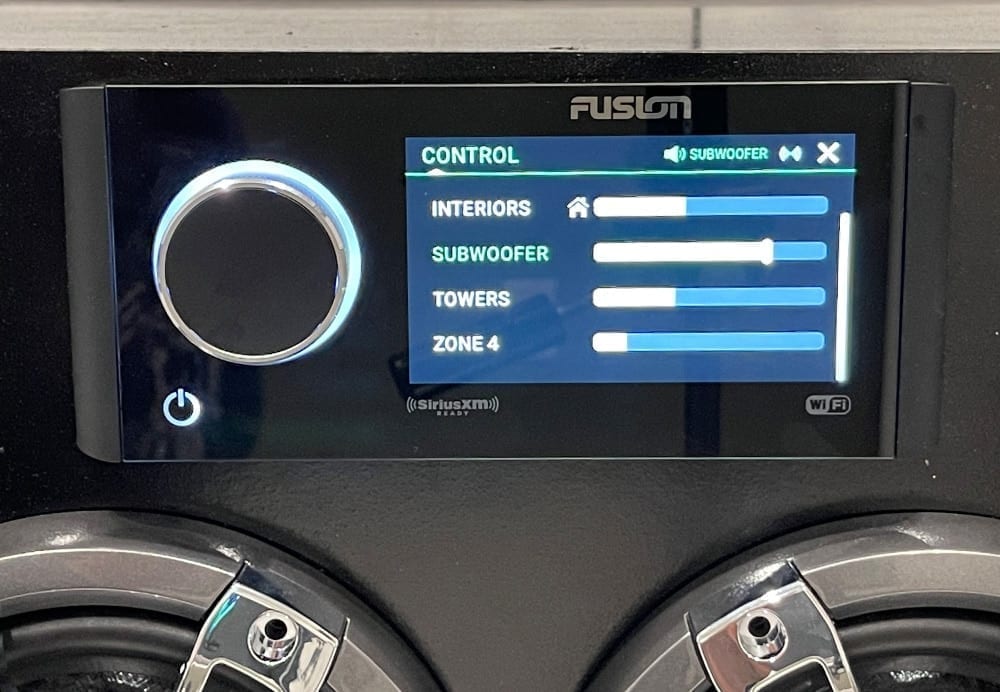
You can enable and disable the zones that you want to use or don't want to use, link them together or control their volumes independently of each other. Each zone can be renamed and the sound output can be customized. This type of control is exactly what I was looking for.
In the zone settings, you also have a 3-band equalizer for each zone along with a low pass adjustment for your subwoofer if you use the zone as a dedicated subwoofer channel. You can even set a max volume/gain on each zone to add some safety boundaries to your zones to prevent damage to the stereo.
I typically prefer a zone control equalizer like Wet Sounds WS-420BT. This type of EQ gives you full (but manual) control over the zones. But this type of equalizer is very touchy, and is much more technical than most people would prefer. For example, if you accidentally max out the bass control on the equalizer of the WS-420 without knowing it and crank up your volume you could do some real damage to the system. It's more difficult to tune and also more difficult to put boundaries on your system to prevent damage.
With the MS-RA770, the zone control is customizable but controlled at the same time which is great for the ‘set and forget' people and even the more audio-control freaks like myself.
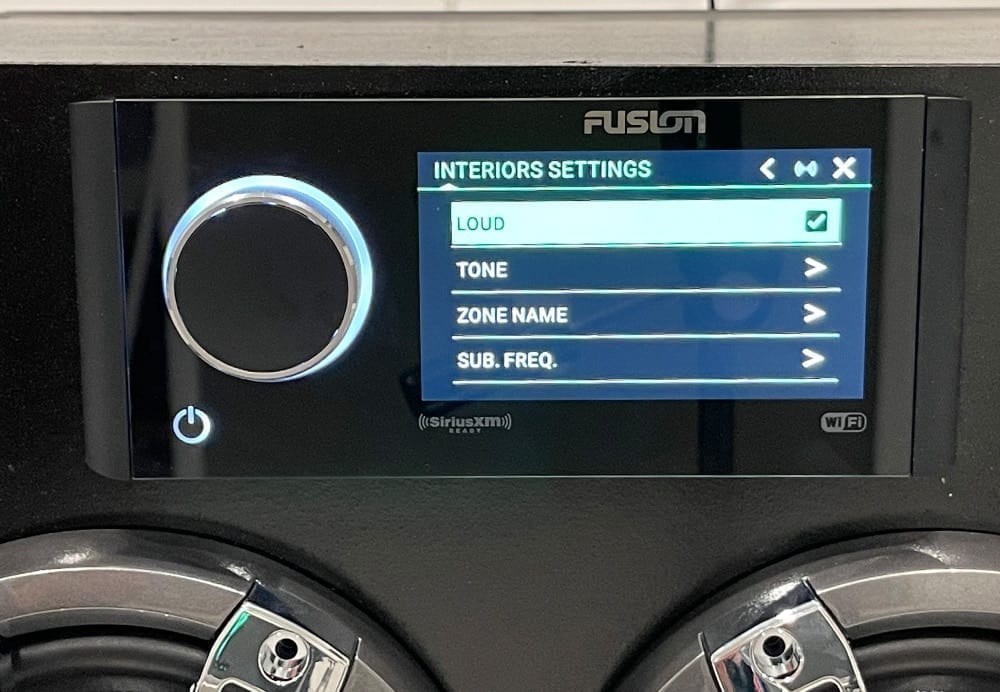
Digital Signal Processing (DSP)
A digital signal processor takes raw audio signals, converts them into a digital format and then passes them through a processor that will modify and tweak the signal to best optimize it for a variety things like:
- Speaker size and type
- Speaker location
- Stereo type
- Stereo location
- Echo and feedback optimization
- etc
DSP really gives an added level of control and tuning that really used to only be available for concert-style setups or high end theaters.
With the MS-RA770, you have a DSP for each zone output at your fingertips. It's within the app (more about the app in the next section) and you can really do some cool things with each of the zones. Let me show you:
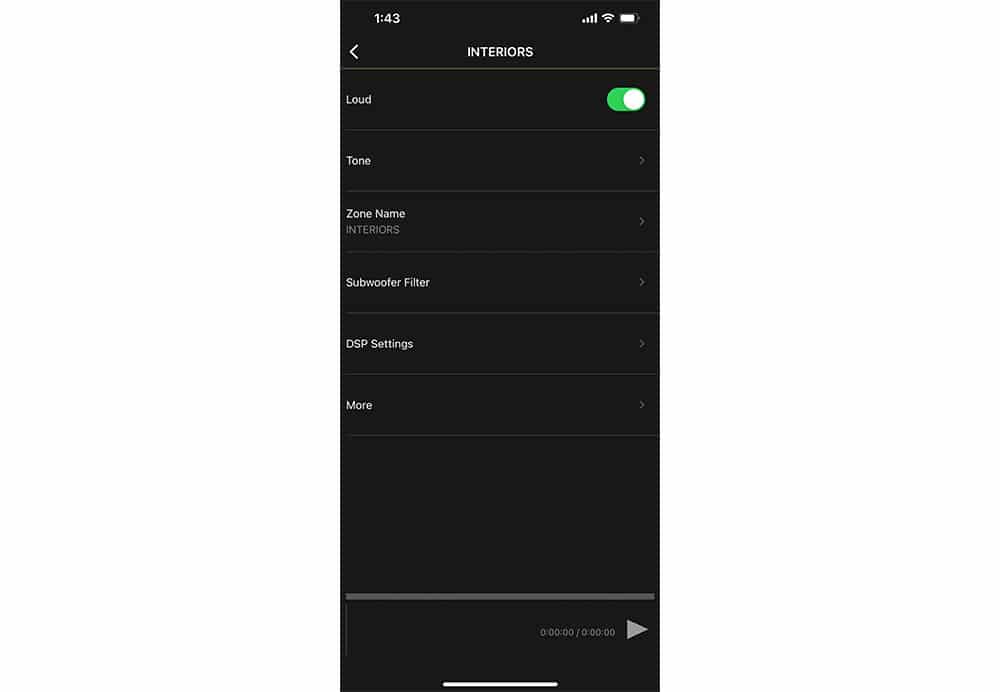
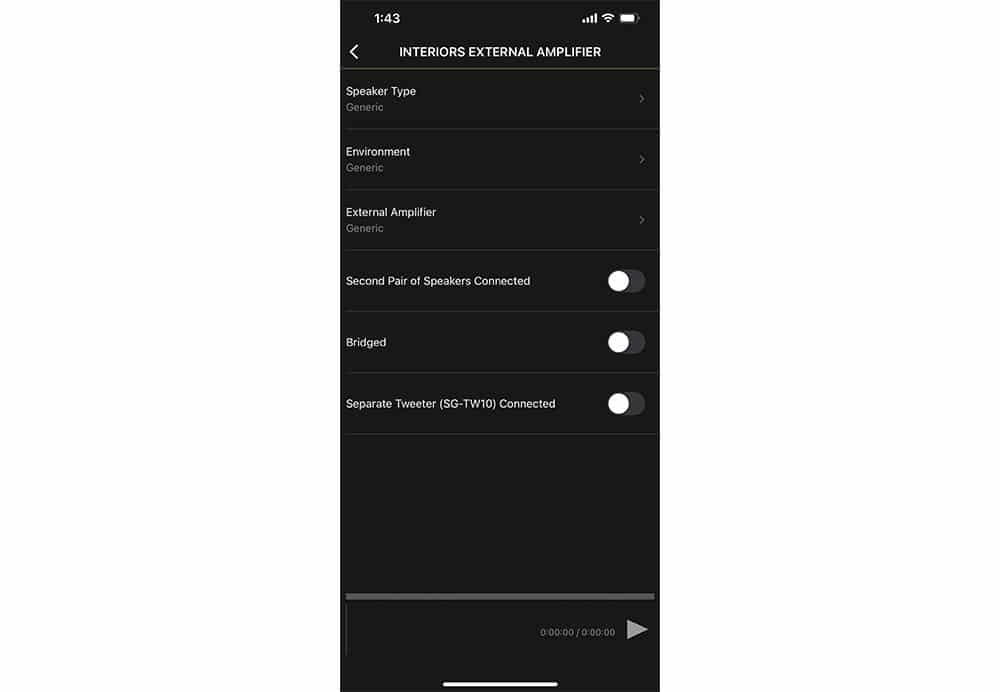
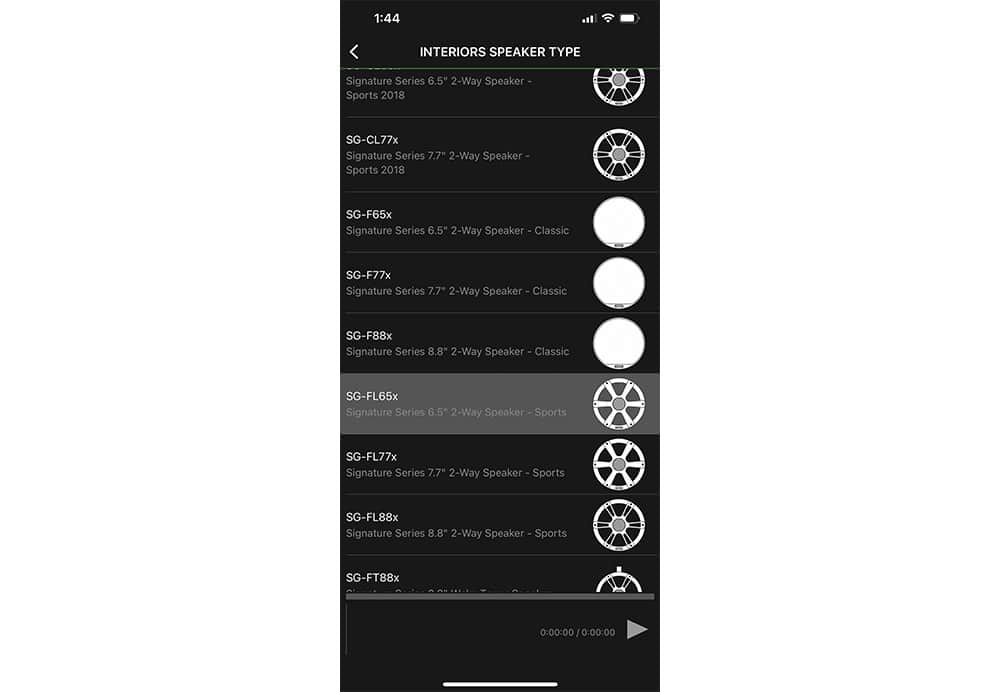
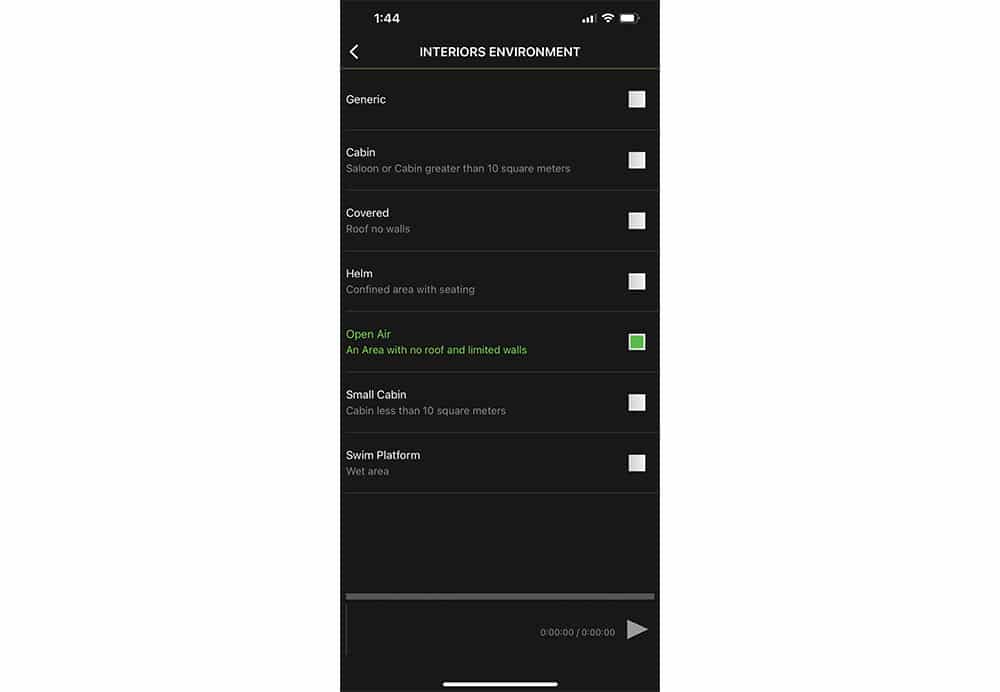
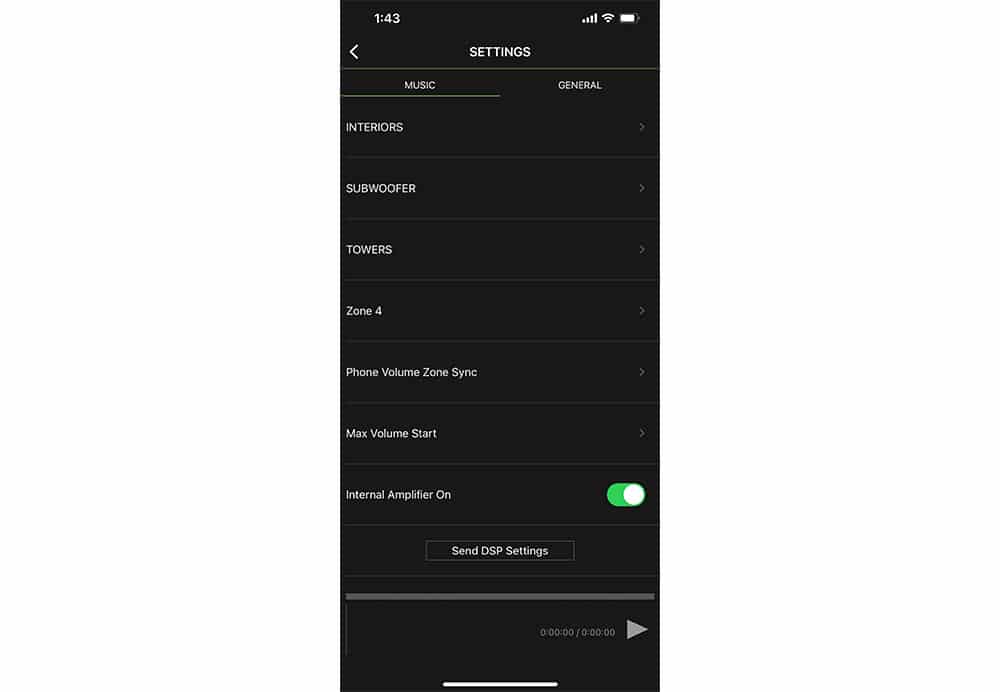
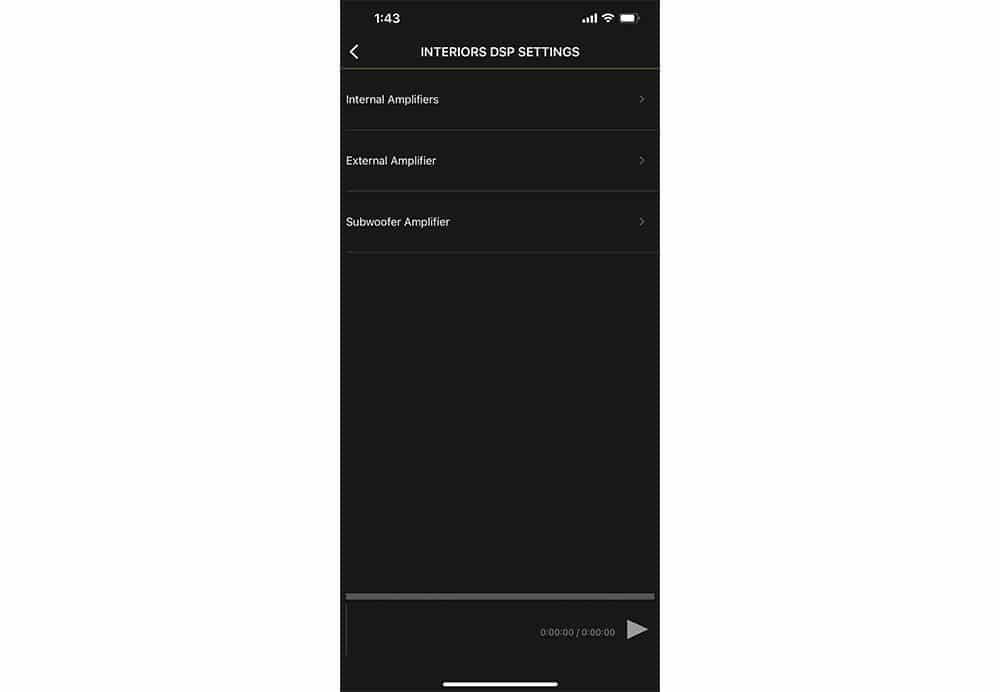
Not only does the DSP feature give you the ability to have a tailored output based on the environment, speaker and amplifier, it really simplifies the tuning process and will automatically set the boundaries of your system if you're using all matching Fusion equipment (in this case we're using fusion speakers, amplifiers, subwoofers and obviously the head unit). In the app, once you select your setup and Fusion speakers, it will tell you what to do on the corresponding amplifier. No live-tuning necessary. The DSP profile is from the Fusion engineers based on the specs of the Fusion products and environment that you select in the app. This is super helpful for the DIY guys who aren't familiar with tuning. I'm really curious how this will sound once this system is installed. Check back for more information about the install and what we think about the sound.
Fusion Link App
The Fusion-Link app can be downloaded from the Google Play store or Apple App Store. The app really gives you full control over the features that are directly on the head unit (and more) right from your fingertips. This includes volume and zone control, source selection, music control, zone customization and DSP settings (like we mentioned earlier), Network configuration and Apple AirPlay settings – almost everything that you'd see directly on the unit.
Once you've downloaded the app and connected to the head unit via Bluetooth, you'll have full control. It's that's simple. My favorite control within the app is actually the zone control. You can modify each of the zones independently with the tap of a finger. Here's a few screenshots of the app on our iPhone.
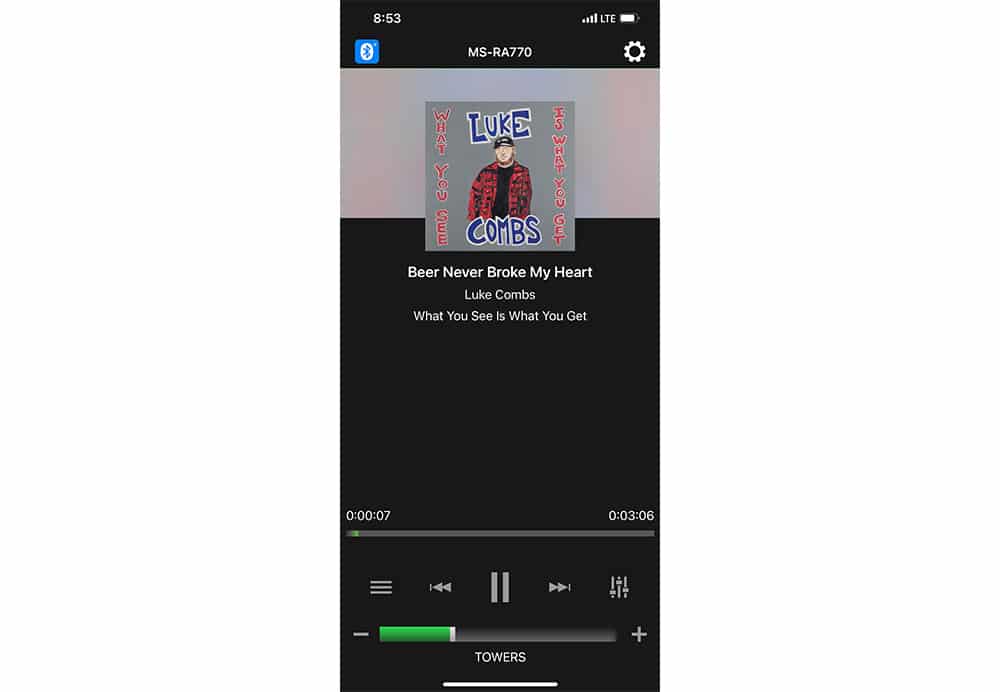
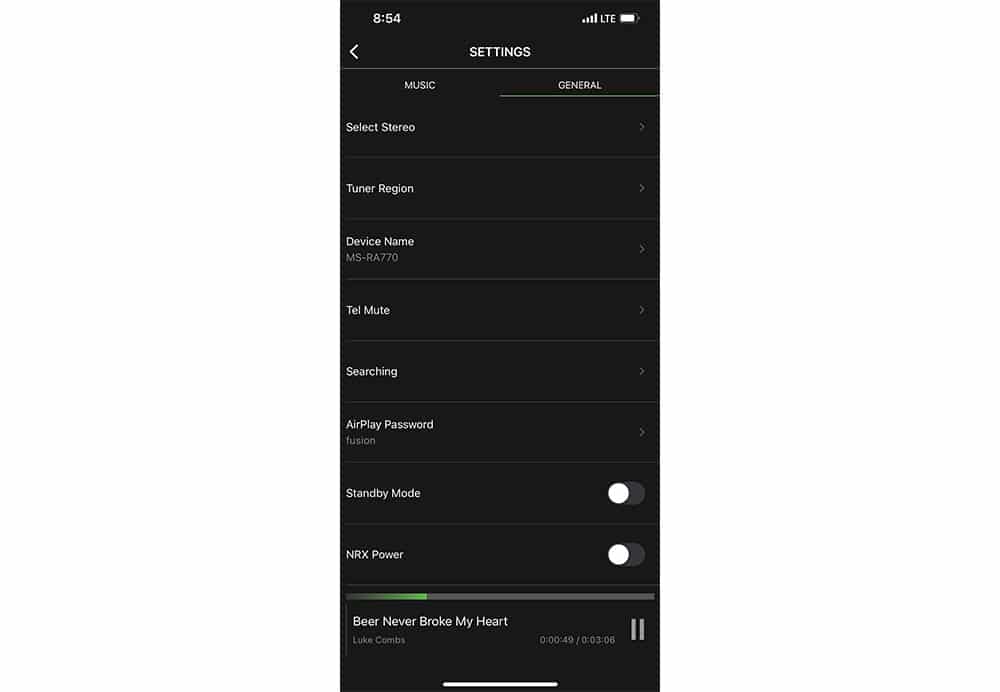
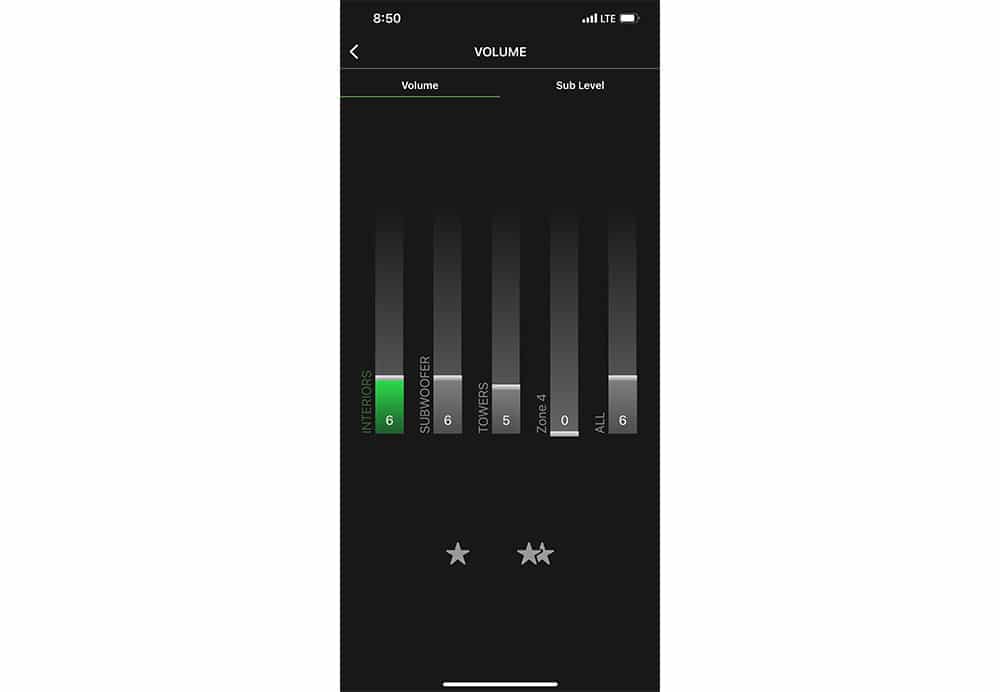
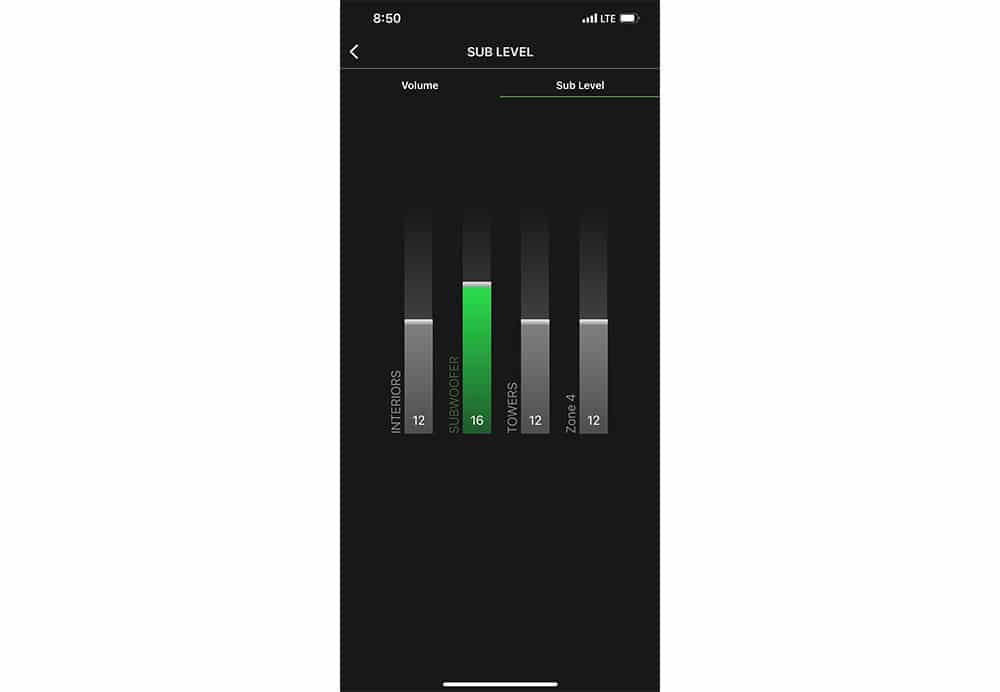
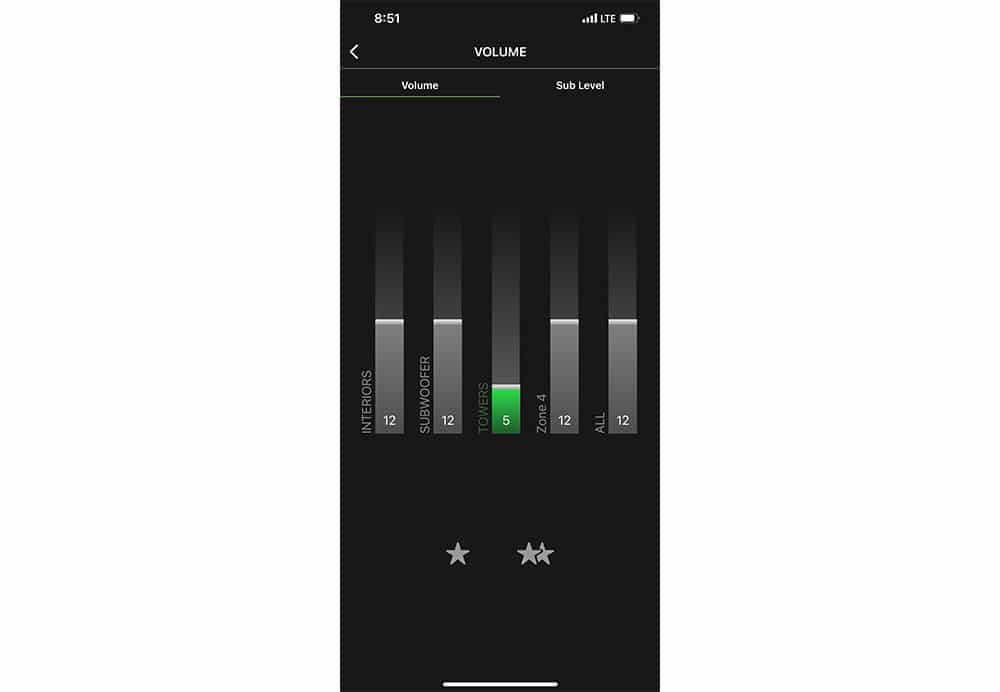
The one thing that I wish the App had was Apple Watch compatibility. I personally leave my phone in the boat whenever I get out and float, moor the boat or park it at the sandbar and use my watch to control the song and the volume from wherever I'm at so that I'm going all the way back to the swimstep or reaching over the rail of the boat to change the song (you couldn't reach over the rail even if you wanted to in a G23). If you had zone control from within the watch app, I think that alone would probably convince a few folks to get an Apple Watch for the summer season if they had a Fusion setup.
But even if Fusion isn't considering making the Fusion-Link app compatible on the Apple Watch, it is compatible with the Garmin Quatix 6 Watch. The Quatix 6 offers a lite version of the Fusion-Link app that allows you to do things like change the volume, source, song, etc. However things like zone control and deeper settings and configurations aren't available on this version of the app.
Conclusion
Fusion's MS-RA770 exceeded my expectations to be honest. Even at the time of this review, a few years after its release, it's still one of the more innovative and feature packed units on the market. The touchscreen does make it easier to navigate through the menus and zone control but I kind of struggled to use a little bit and resorted to using a combination of the touchscreen and the control knob which proved to be most efficient.
WiFi/AirPlay is a nice touch too, and really increases the distance you from which you can play music on the head unit with your phone or other music device. But in the few minutes that I tested it out there was one or two minor interruptions. Likely because I'm in my home with 10s of devices nearby. I don't think this will be an issue on the water and I would likely prefer to use the AirPlay over Bluetooth.
The zone control + zone DSP profile configuration really stood out to me. Zones control – whether it be a manual zone control like the WS-420BT or digital like this Fusion head unit – is crucial on a high performance wakeboard boat stereo. I really enjoyed configuring the zones and then applying a DSP profile that matched the exact products and application for each zone. It also simplified tuning (assuming I like the DSP profile when we test it out on the water).
From my in-person testing on the unit, I really have little complaints about the head unit. I would like to see Apple Watch app compatibility on their roadmap though with zone control! After speaking with the Fusion folks, this doesn't appear to be on their radar at the time of this review but who knows!
If you're going to go with a Fusion setup – amplifiers, tower speakers, subwoofers, interior speakers – a Fusion head unit like this MS-RA770 is a no brainer. It's really set up to complement all of the other Fusion products. Just look at the DSP settings.. If you don't have Fusion products, the zone control would probably be the next best selling feature (for me personally). All in all, impressed with this head unit and definitely would recommend it for a variety of setups. Check out our full stereo install on an Axis A22 for more details about where we installed this unit.

